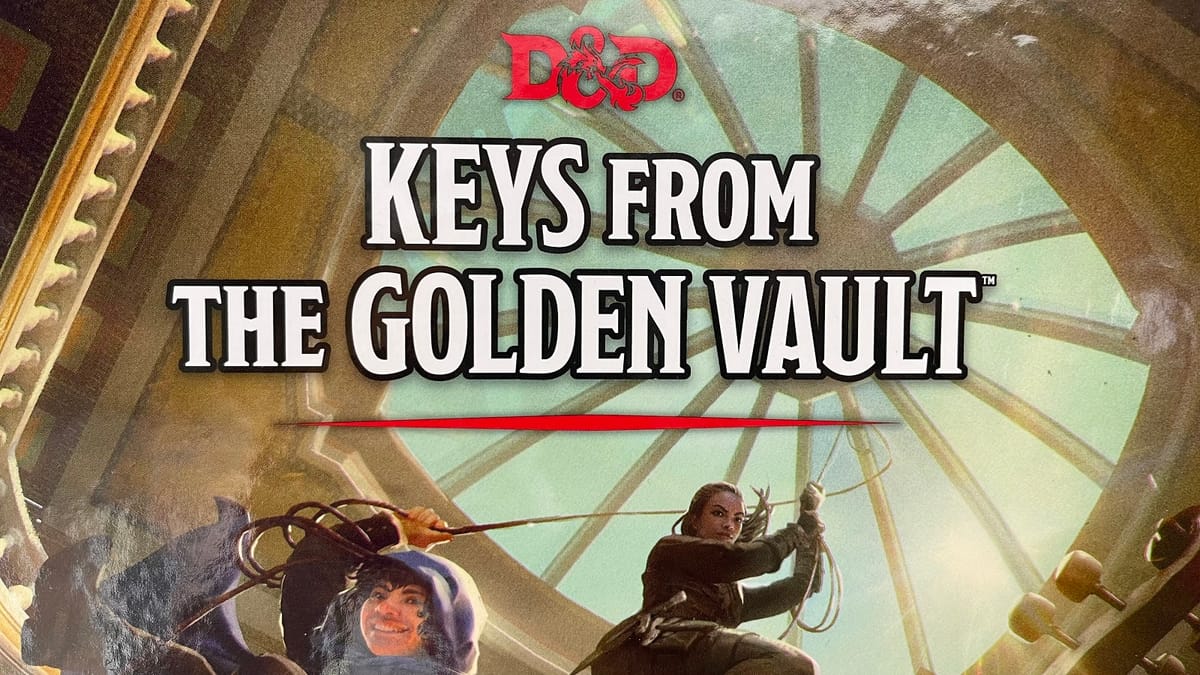
Wizards of the Coast (WotC) has populated the shelves of 5th edition Dungeon Masters with a lot of hardback adventures. From WotC’s offerings, groups can adventure in the various official settings. They can face off against dragons, giants, demons, and devils. Players can travel to other planes, or even go to school. For D&D groups, 5E has offered plenty of published adventures throughout its run.
With Keys from the Golden Vault, WotC revisits the heist, a style of adventure that formed the backbone of the aptly named Waterdeep: Dragon Heist. Based on the popular and classic movie genre, heist adventures focus on receiving, planning, and executing some sort of mission – often a theft. Unlike Dragon Heist, which was more of a treasure hunt and focused on one storyline throughout for characters starting at first and ending at fifth level, Keys from the Golden Vault is a collection of thirteen different heist adventures designed for character levels one through eleven.
This book, like many in 5E D&D, was published with two covers. The standard cover artwork depicts a pair of adventurers entering a building via ropes from a vaulted skylight while a tiny demon (a quasit to be exact) lurks below. The painting is looking up from the ground, putting the quasit in the foreground and the adventures high overhead. It makes excellent use of perspective to maximize the D&D cover style and communicates the theme of the book. The alternate cover, available in brick-and-mortar stores, is a gold and black vault theme. The front and back look as if it were a vault itself, with the front resembling the door of a decorated vault. It has an Art Deco architectural feel with repeated patterns of rays and lines. Both covers are very nice and I would be happy with either on my shelf. For those who are collecting one set or the other, you won’t be disappointed with either cover.
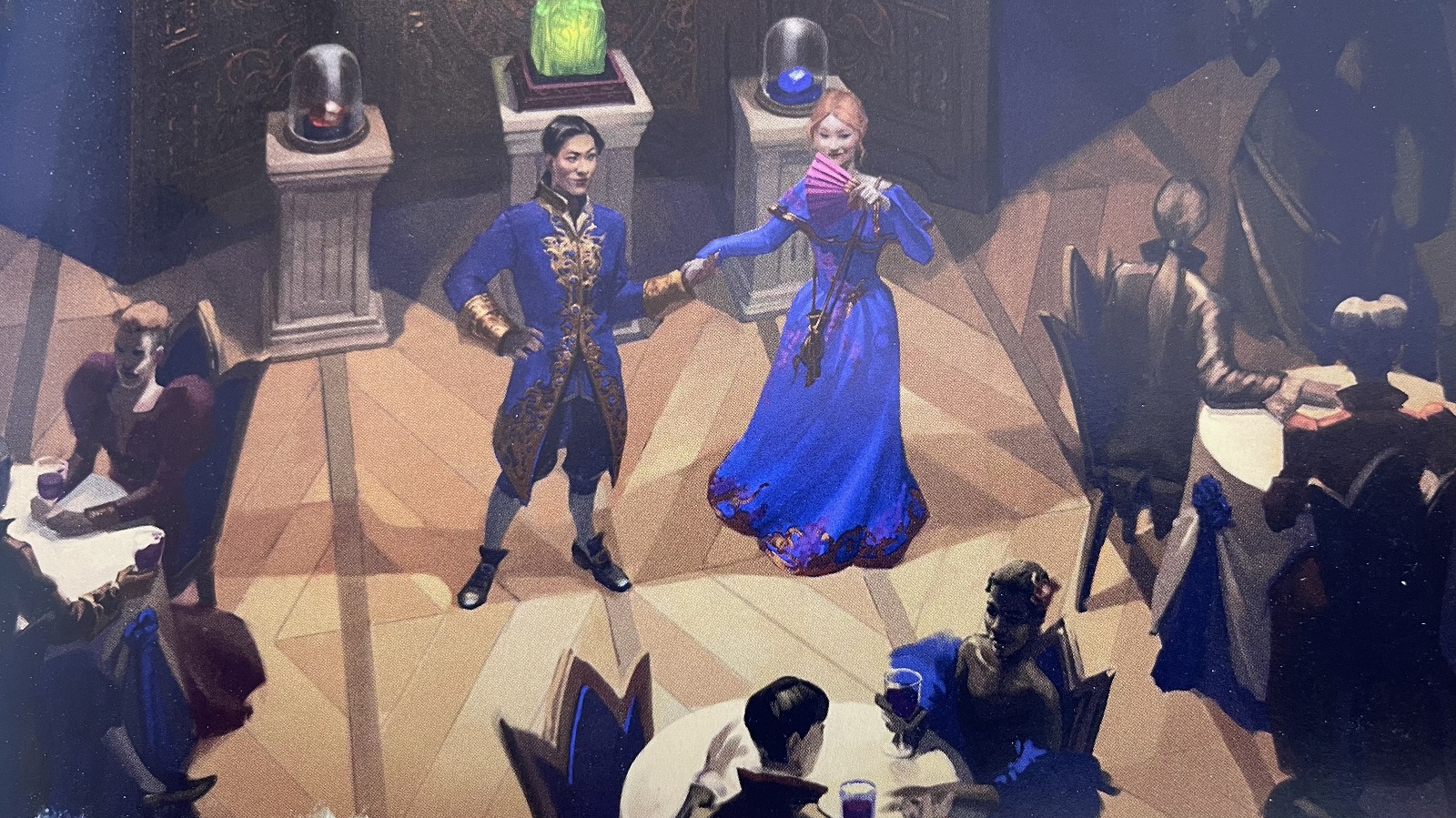
A scene from the first adventure.
Keys is essentially a collection of unrelated adventures tied together by the theme. There is no continuous storyline connecting the adventures throughout the book like in other hardback adventures such as Storm King’s Thunder, or Curse of Strahd. Instead, this book follows the lead of other anthology-style books like Tales from the Yawning Portal and Candlekeep Mysteries, providing an overarching mechanism to connect the adventures together for DMs that want to do that. This structure provides DMs with the option of running all the adventures in the book in sequence as the player characters level up, or to grab just one adventure to fill in a gap in campaign or as a break from a main storyline.
The unifying mechanism provided in the book is an organization known as the Golden Vault. The Golden Vault is a secretive organization that essentially does good deeds across the multiverse. The player characters can be recruited by the Golden Vault and then sent on the various heists at the behest of the organization. Once part of the Golden Vault organization, players receive Mission Impossible-style vanishing messages at the beginning of each heist. I really like the concept and delivery style, it’s creative and thematic, and while not a huge secret, I wouldn’t want to spoil it here. The Golden Vault organization itself is not very detailed. I would have loved to have seen more characters and information about them. There could be a few more pages on them, maybe even a base of operations, or some information about how to contact them in various areas of the multiverse.
An issue that can come up for a game group contemplating a heist is the moral issue of stealing. Most D&D groups center on the player characters as forces for good, righting wrongs and conquering evil. While thieves have been part of the D&D player character options since the early days, their less savory activities are usually executed in the interest of the greater good, to help the group stop evildoers and the like. Having the entire group plan and commit theft over and over again seems like it would go against what many D&D groups are about.
Two things help square the actions in the adventures with the goals and general alignments of most gaming groups. First, like most heist movies, where the audience needs to be rooting for the thieves, most of the heists themselves are built around the players taking something from the bad guys to prevent bad things from happening. Second, the Golden Vault organization is described as illegal, but supporting a just cause. So, there is a moral equivalency going on of the ends justifying the means: it’s better to do a little bad for the greater good. Either way, the book does a good job of giving DMs the tools they need to help a group of good guys to do bad things. All of this setup is essential for DMs because in the movies, the heist genre relies heavily on the reformed bad guy to get the audience behind the main character committing the crime. Unless the group builds their characters to that trope, that avenue is not available to the DM, so they need another way to entice the players into essentially committing crimes.
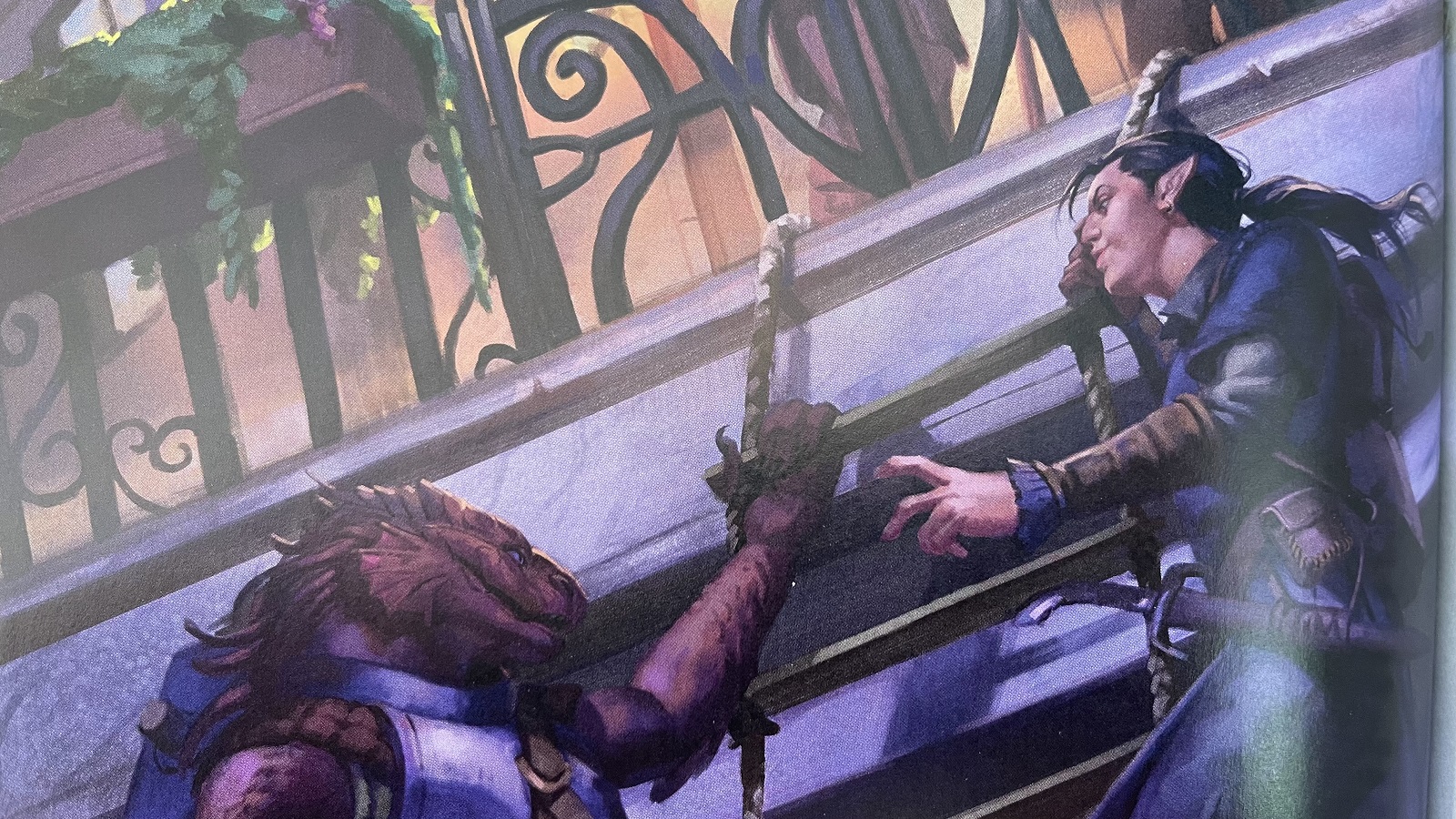
A key part of any heist is getting past the guards.
Other than the Golden Vault organization to help get the ball rolling, DMs are presented with a few options for making things a bit more complicated for their players. From my perspective, it’s always good for a DM to have the ability to tweak the difficulty of an adventure while it’s playing out. If the players are just sailing through an adventure without any sense of danger or risk, then the reward at the end can feel unearned. On the other hand, if the players are making little to no progress on an adventure, the game can become frustrating and less fun. It’s a fine line that DMs have to walk. Here, Keys offers DMs a few options to keep the story moving and challenging. My favorite is the potential of a rival crew going after the same goal as the players. There’s just enough here to give DMs what they need to add that element into each of the thirteen adventures.
Each adventure is laid out in the standard WotC style that communicates exactly what a DM needs to get from the beginning to the end without trouble. They all come with a background, a section tying the adventurer to the Golden Vault organization (with an accompanying illustration of a unique key), and a call-to-adventure style set up. Each has an expertly illustrated map with keyed locations, like a standard adventure. Accompanying the map and locations is a thorough description of the location and events that occur at the location.
These adventures keep to the Murphy’s Law concept of heist movies – if something can go wrong, it will. Just like in a heist movie, no matter how well the heroes plan, something happens to cause them to adjust their plans on the fly. Maybe a guard shows up in an unexpected place. Maybe a roll of a 1 on an ability check causes the player character to make a noise. Whatever the cause, things can change, such as increased guard forces, or simple wandering monsters.
The settings are interesting and some are outstanding. While many can be placed in any setting like a Svirfneblin town that could be anywhere, but a few others are setting specific such as the Forgotten Realms prison of Revels End. Of course, you can relocate the prison anywhere and change its name, but it is nice to have the setting tie-in for those that want to use it. Some of the settings really shine. For instance, one adventure takes place on a train in the outerplanes – a train heist in D&D? I’m all for it! A creative DM might even be able to convert the train to a Lightning Rail in Eberron.
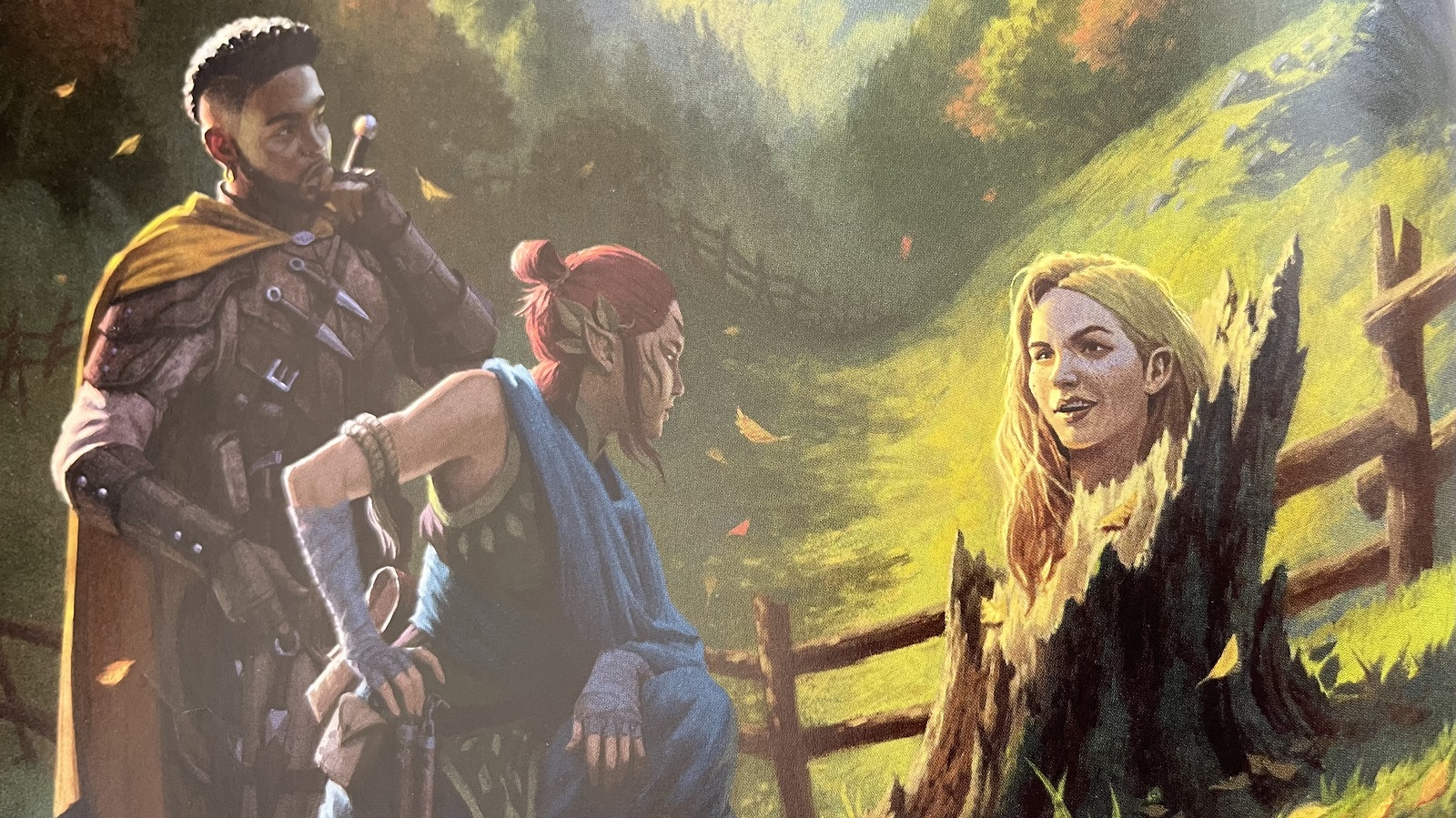
A D&D heist has fantastical elements.
In addition to a variety of settings, there are a variety of objectives too. The players aren’t just stealing the crown jewels from the evil king over and over. Each adventure has a unique goal with an interesting story to support it. My favorite by far has to do with ending a curse by recovering a stolen heart. I love that kind of creativity – it’s a heist, but it’s definitely a D&D heist. It’s nice to revisit the Feywild in another heist. In each case though, the location of the heist is movable, all can easily be dropped into a homebrew setting, or any of the available published settings.
Unlike some other published adventures, there are not a bunch of new creatures and items in this book. There are a few stat blocks for new creatures, and there are some new items, but generally, this book relies heavily on the core rules to provide the creatures and magic. DMs that buy adventures to use as source material will find the pickings in here a bit slimmer than others.
Consistent with all the WotC 5E publications, the artwork in Keys is just outstanding. The illustrations are evocative of the scenes and well done. Combined with the great maps and the cover artwork, the art direction is great!
I don’t want to go into the details of the individual adventurers, for fear of spoilers, but I will say that they are all good. The level progression works pretty well, so playing them one after the other will work. There are repeat level adventures, two fifth level and two eighth level. This is not a big deal, as you can skip one if your group is leveling up after every adventure, the DM can tweak the levels, or you can just run the adventure with the level a little low.
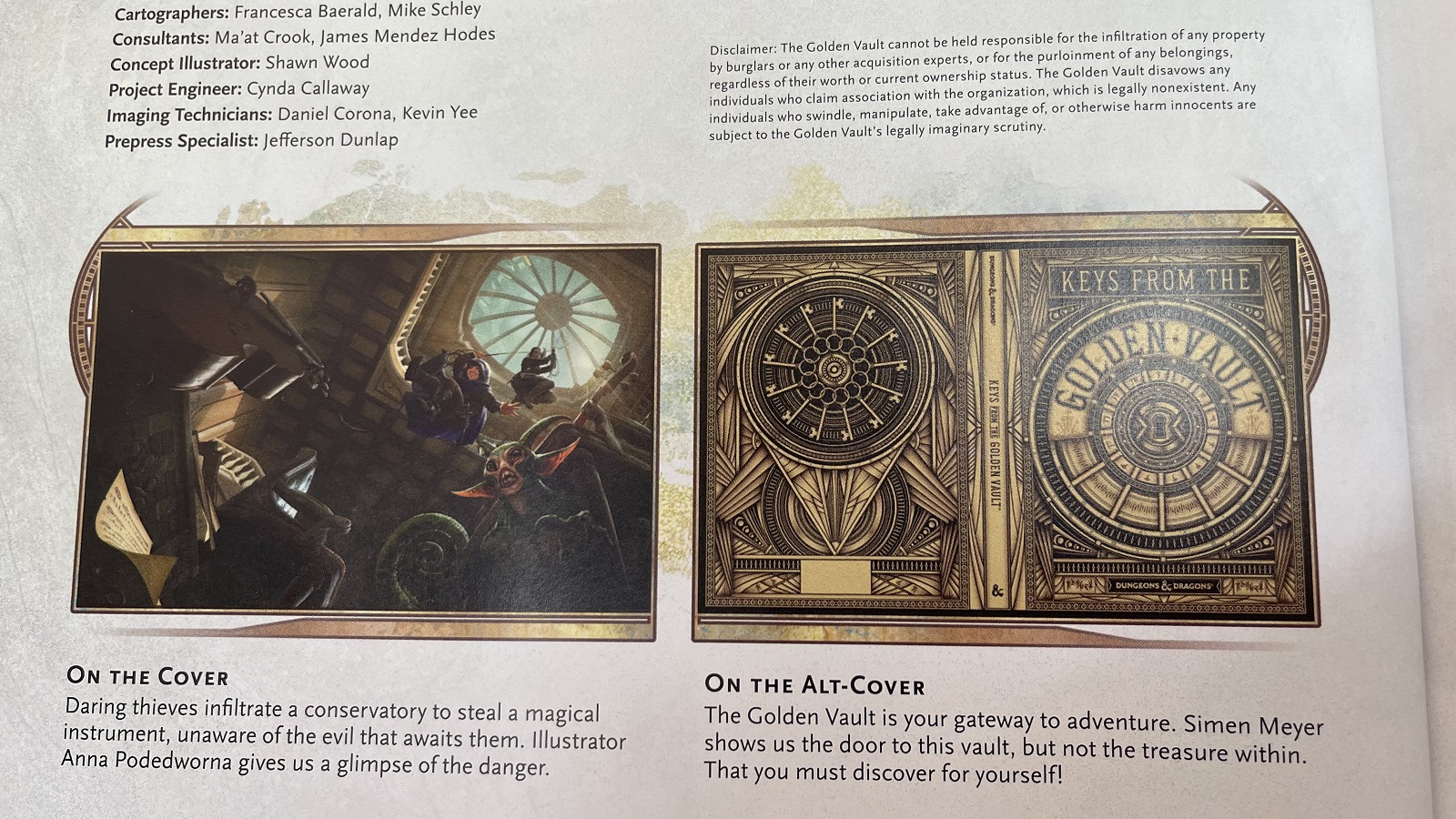
Both covers are described inside the book and the humorous disclaimer is there too.
The challenge with these adventures is in the plan and execution, more than the monsters fought. In fact, that’s where these adventures shine. Rather than just loading up on gear and charging into a dungeon, these adventures require the players to survey their objectives, think about the patterns of life, and come up with a way in and a way out. There are plenty of opportunities for roleplay here. The settings are not conducive to just hacking your way in and out. The whole idea of a heist is stealth, subterfuge, and deception. Groups that lean into the theme are sure to have a lot of fun with what is presented here. Groups that treat each heist as just a raid may succeed, but they’ll miss out on the real fun.
At the same time that planning is key to these adventures, that might also be their Achilles’ Heel. The planning portion could be a challenge to pull off around the gaming table and it seems prone to bogging down. There’s a real risk of the players talking a plan to death over an entire gaming session. Also, it requires everyone to understand the situation and have a pretty good comprehension of the target area. If the situation is unclear or there is a miscommunication between the DM and the players, the planning session could go astray, so DMs must ensure they are clearly articulating the appropriate details to the players. It’s also possible that some players may find all the planning boring. There’s a variety between the adventures too, where some can be accomplished with very little planning and a lot of on the fly decision-making, while others hinge on a good plan. Groups that come up with a bad plan may find their adventure going off the rails and losing luster fast.
Finally, all of the adventures are short – consistently around 15 pages each. For some, there appears to be enough information for a DM to get through without a lot of extra work, but for some the DM may have to fill in a lot of gaps. Filling in unexpected gaps during a dungeon crawl may not be too hard, but it might be asking a lot for a DM to fill in gaps for a heist. Ultimately, I think the DMs that use these adventures need to do a good deal of prep and really pay attention during the planning phase for any potential player misunderstandings or critical knowledge gaps.
Keys From the Golden Vault
Great
A good set of adventures that can be played together or in isolation, Keys to the Golden Vault is a handy resource for DMs. Focusing on heists opens up a lot of roleplaying opportunities and changes the emphasis of a game session to the preparation part of the adventure. Artwork and design is excellent and conducive to easy reference, making the book a pleasure to read. Players and DMs may struggle with implementing the adventures as heists depending on skill level and play style. DMs should be prepared to work a bit harder to successfully run these adventures.
Pros
- Interesting settings and novel plots-
- Options for the DM to adjust difficulty
- A variety of adventures that can be played together or separately
Cons
- Heavy reliance on planning makes DM player communication vital
- Miscommunication between DM and player can totally derail the adventure
- Play can likely get bogged down in the planning stage
